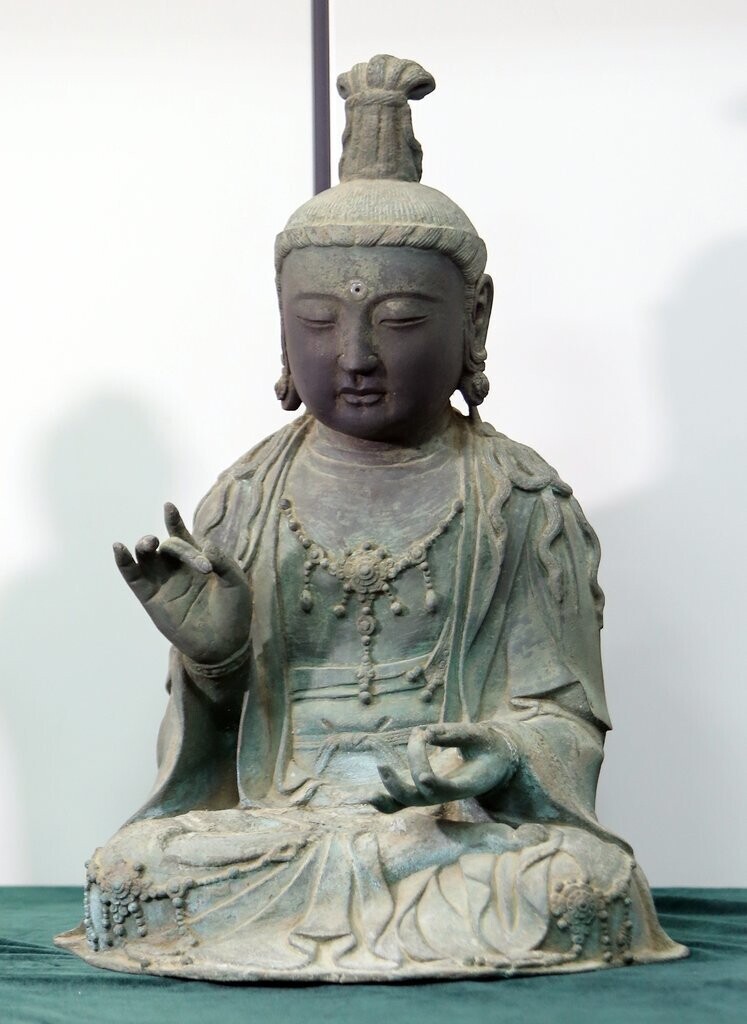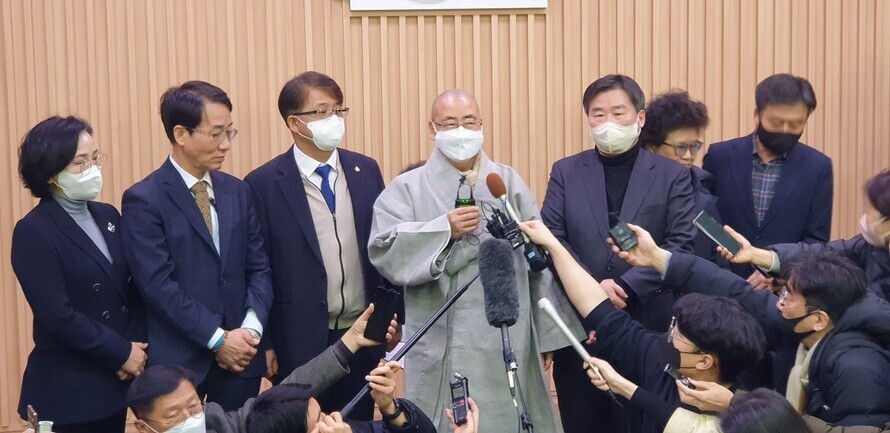hankyoreh
Links to other country sites 다른 나라 사이트 링크
Once raided from Korea then stolen back, a 14th-century Buddhist statue may be returned to Japan

In a lawsuit over the ownership of a Goryeo-era Buddhist statue that was brought back to Korea by thieves, a South Korean high court has ruled that the statue does not belong to a Korean temple.
The ruling comes 11 years after the statue was taken from Tsushima, Japan, to Korea. The Korean temple that’s suing for ownership of the statue said it would appeal to the Supreme Court.
The first civil division of the Daejeon High Court (under judge Park Seon-jun) ruled on Wednesday that Buseok Temple (affiliated with the Jogye Order of Korean Buddhism) had not established ownership of the Buddhist statue in question. Buseok Temple, in Seosan, South Chungcheong Province, had asked the court to recognize its ownership of the statue, which depicts a seated Avalokitesvara Bodhisattva.
The court found that while the statue had indeed originally been the property of Buseok Temple, in Seoju, in the Goryeo dynasty, today’s Buseok Temple in Seosan cannot be regarded as the same temple as the one in the past.
“Considering factors such as how the Seoju area was devastated in frequent Wokou raids in the late Goryeo dynasty, we do not find that the human and physical elements of Buseok Temple in Seoju are identical to or in continuity with the Buseok Temple in Seosan today,” the court explained.
“There is considerable evidence to believe that the Wokou seized the Buddhist statue in a raid and brought it illegally to Japan,” the court acknowledged, but added that “because Kannon Temple [in Japan] held the Buddhist statue for 20 years after its establishment as a corporation in 1953, it completed the period for establishing ownership.”
The Avalokitesvara Bodhisattva statue in question, which measures 50.5 centimeters tall and weighs 38.6 kilograms, was produced in the Goryeo dynasty in the 14th century. A document found inside the statue said that the Buddhist statue was made in the second month of Emperor Wenzong of Yuan (that is, the year 1330) and placed in the care of Buseok Temple in Seoju, the former name of Seosan.
The Korean academic community refers to the statue as the “Seated Avalokitesvara Bodhisattva of Boseok Temple in Seosan.”
While it’s presumed that the statue was enshrined at Kannon Temple, on the Japanese island of Tsushima, in 1527, it’s uncertain how the statue reached Tsushima.
Since the Wokou pirates frequently raided Seosan after the statue was enshrined at Buseok Temple and since the statue still contained relics after being moved to Kannon Temple despite the lack of papers detailing an official transfer, it’s widely thought that the statue was probably taken to Japan following a raid.
The Buddhist statue returned to Korea in October 2012 when a team of thieves stole it from Kannon Temple and brought it into Korea via the port of Busan.
The thieves were apprehended by investigators with the Daejeon Metropolitan Police Agency that December, and the statue was confiscated and brought to Daejeon. When the news became known, it sparked a debate about what to do with the statue that had returned to Korea after a 500-year absence.
Worshippers at Buseok Temple and other residents of Seosan set up a committee to “restore the Seated Avalokitesvara Bodhisattva Statue to its rightful place” and launched a campaign for the statue’s reinstatement at the temple. In February 2013, the Daejeon District Court granted Buseok Temple’s request for an injunction to halt proceedings for returning the statue to Japan. That allowed the statue to stay in Korea for the time being.

After the injunction period ended in February 2016, Buseok Temple filed a lawsuit at the Daejeon District Court in March asking the Korean government to recognize its ownership of the statue.
In January 2017, the Daejeon District Court ruled that ownership of the Buddhist statue should be given to Buseok Temple.
“There is ample reason to presume that this statue belongs to Buseok Temple in Seosan. We must assume that the statue made its way to Kannon Temple in Japan through theft or plunder, rather than through normal means such as donation or sale,” the court ruled.
But the controversy continued after the district court made its ruling. The Tsushima city council adopted a resolution asking for the statue’s return, and Japan’s chief cabinet secretary and culture minister made the same request during meetings with their Korean counterparts.
In Korea, public opinion was split between the view that the statue was Korean to begin with and the view that it was stolen property that should be returned to Kannon Temple.
According to a UNESCO convention about the illicit transfer of cultural property that was adopted in 1970, ownership of cultural properties that have been illegally transferred can be exercised by the original property holder.
In an appeal that began in March 2017, the high court didn’t recognize Buseok Temple’s ownership of the statue, parting ways with the district court’s ruling.
“Separately from our rejection of the plaintiff’s appeal for transfer of ownership, the government of the Republic of Korea needs to address the question of returning this statue in light of the spirit of the convention about returning cultural properties and international legal principles for the protection of cultural properties,” the court said, calling on the Korean government to tackle the issue.
After the court’s verdict, representatives for Buseok Temple announced their decision to appeal to the Supreme Court.
“We absolutely cannot accept the court’s ruling that the Buseok Temple that was in Seoju during the Goryeo dynasty is not the same as the Buseok Temple that is in Seosan today. The court ought to have employed another legal principle to explain the rationale for its ruling.”
The statue is currently being stored at the National Research Institute of Cultural Heritage, in the Yuseong District of Daejeon.
By Choi Ye-rin, staff reporter
Please direct questions or comments to [english@hani.co.kr]

Editorial・opinion
![[Column] Park Geun-hye déjà vu in Yoon Suk-yeol [Column] Park Geun-hye déjà vu in Yoon Suk-yeol](https://flexible.img.hani.co.kr/flexible/normal/500/300/imgdb/original/2024/0424/651713945113788.jpg) [Column] Park Geun-hye déjà vu in Yoon Suk-yeol
[Column] Park Geun-hye déjà vu in Yoon Suk-yeol![[Editorial] New weight of N. Korea’s nuclear threats makes dialogue all the more urgent [Editorial] New weight of N. Korea’s nuclear threats makes dialogue all the more urgent](https://flexible.img.hani.co.kr/flexible/normal/500/300/imgdb/original/2024/0424/7317139454662664.jpg) [Editorial] New weight of N. Korea’s nuclear threats makes dialogue all the more urgent
[Editorial] New weight of N. Korea’s nuclear threats makes dialogue all the more urgent- [Guest essay] The real reason Korea’s new right wants to dub Rhee a founding father
- [Column] ‘Choson’: Is it time we start referring to N. Korea in its own terms?
- [Editorial] Japan’s rewriting of history with Korea has gone too far
- [Column] The president’s questionable capacity for dialogue
- [Column] Are chaebol firms just pizza pies for families to divvy up as they please?
- [Column] Has Korea, too, crossed the Rubicon on China?
- [Correspondent’s column] In Japan’s alliance with US, echoes of its past alliances with UK
- [Editorial] Does Yoon think the Korean public is wrong?
Most viewed articles
- 1‘We must say no’: Seoul defense chief on Korean, USFK involvement in hypothetical Taiwan crisis
- 2N. Korean delegation’s trip to Iran shows how Pyongyang is leveraging ties with Moscow
- 3‘Weddingflation’ breaks the bank for Korean couples-to-be
- 4Will NewJeans end up collateral damage in internal feud at K-pop juggernaut Hybe?
- 546% of cases of violence against women in Korea perpetrated by intimate partner, study finds
- 6[Column] Park Geun-hye déjà vu in Yoon Suk-yeol
- 7“Parental care contracts” increasingly common in South Korea
- 8[Column] Yoon’s first 100 days should open our eyes to pitfalls of presidential system
- 9[Interview] Dear Korean men, It’s OK to admit you’re not always strong
- 10[Editorial] New weight of N. Korea’s nuclear threats makes dialogue all the more urgent